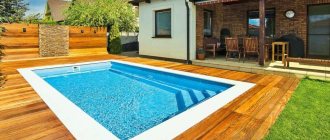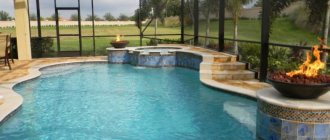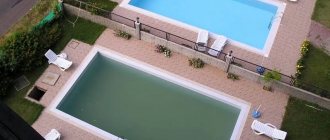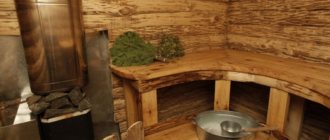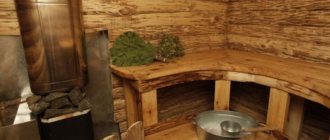On weekends, many residents of our homeland strive to quickly go to their dacha from their cities to breathe fresh air, enjoy nature and take a break from the bustle of the city. And if you have a swimming pool, then the question arises: How to heat a pool in the country?
Swimming in cold water is not fun. And if children also swim with you, they can easily get sick.
Let us remind you that the comfortable water temperature in the pool for an adult is from 25 degrees Celsius, and for children - from +29 degrees.
Today we’ll look at what methods we can use to heat a pool at the dacha. Moreover, we will consider both the devices offered by manufacturers and traditional methods.
Basic methods of heating pool water
In order not to harm your health, and especially not to harm your children, every owner of a country pool should know that the water temperature should be:
- When bathing adults : +24 – 28°С.
- For health procedures : +26 – 29°С.
- Children under 7 years old : +30 – 32°C.
- For children over 7 years old : +29 – 30°C.
- Hydromassage baths are taken at a temperature of +35 – 39°C.
Based on these requirements, owners of summer cottages need to decide which heater is best suited for the size of their pool. Often the choice is influenced by the financial side. But an important aspect is the availability of the necessary communications, as well as the preferences of the owner of the dacha.
Flow-through electric heater
This is the most common option. From relatively inexpensive to models capable of heating fairly large areas. Adjusting the water temperature is achieved by increasing or decreasing the pressure. The greater the pressure, the less heating. The most popular heater with a power of 3 kW raises the temperature by one degree in a ten cubic meter pool in one hour.
Flow-through electric heater Source allegro.pl
But the most powerful flow-through heater, with a power of 18 kW, can maintain the desired temperature in a pool with a volume of no more than 36 m3. Therefore, the owners of the “Olympic tracks” need to look for another option. For example, the next one.
Heat pump
A heated swimming pool for a summer house can be supplied with a heat pump. It pumps out heat instead of water. He can take it from the bowels of the earth, a reservoir, and even from the air. The operating principle of the device resembles a conventional refrigerator. When the pumped-out heat enters the refrigerant, the inert gas boiling in it is compressed by the compressor to 25 atmospheres. The heat released in this process very quickly heats the water, which circulates through the pipeline.
Such a system is capable of heating large volumes of water in a very short time. The disadvantage of the device is that it only works in warm weather. Ordinary summer residents cannot afford such a new product. The price of a heat pump starts from 120 thousand rubles.
Heat pump Source grephys.com
Heat exchanger
If the house has steam heating, then a heat exchanger can be connected to it. Cold water from the pool enters the coil, which will be heated by hot water circulating through the heating system of the house. Heating is adjusted using a thermostat. It increases or decreases the speed of water flow in the coil.
This method is suitable for indoor pools and in winter. In summer, turning on the heating in the house in order to swim in the pool is extremely irrational.
Heat exchanger Source proekt-sam.ru
See also: Catalog of companies that specialize in swimming pools and equipment for them.
Solar panels
A garden pool with water heating using a solar collector is becoming more and more popular. Solar systems are very efficient. Especially modern models that have touch sensors and automation. But they are very expensive and therefore not available to everyone. The second disadvantage is that they only work in sunny weather.
You can choose a design that will perform simple heating functions and therefore its price will be quite reasonable.
Solar battery Source orcmaster.com
Budget options
Let's look at the options that can be used, as they say, at worst. These are far from the most practical methods, but they are very cheap and accessible to everyone.
Boiler or kettle
Kettle for heating water
If you have a very small pool for children, then you can heat the water to the desired temperature in a simple, proven way. Just heat up the water in several pots and a kettle. The solution to the problem is not surprising, and it has its advantages.
Pros:
- For free;
- Available.
Minuses:
- Only for miniscule volumes;
- A frustrating process.
Snail
The snail is a mini solar collector. They have a similar operating principle. The water is taken into the pipes, heated by the sun and returned to the pool. Its design is so simple that homemade snails are not such a rare occurrence.
Snail for heating
Since this is a brother of the solar collector, the pros and cons are similar. But the snail is smaller in size, so it wins in price, but loses in efficiency.
You may be interested in: Do-it-yourself sand filter for a pool
Pros of using snail:
- Very affordable price;
- Does not require installation;
- Easy to use.
Disadvantages of using a snail:
- Effective only in sunny weather.
Thermal heating blanket
A thermal blanket can also help you heat up the water in your pool. It is also called “Special Pool Covering”. You simply stretch a special fabric over the pool, and now the heat from the sun is not reflected from the water, but is retained by the coating. Thus, in a few hours the water can warm up by 3-4 degrees.
Thermal heating blanket
It should be noted that in the case of a special coating, only the top layer of water is heated. To ensure that the water heats evenly, turn on the pump, which will mix the upper and lower layers.
Usually they buy a thermal blanket for a swimming pool of a special shape for a specific model. If you have a custom-made pool, then you can cut out the film yourself or order it.
Pros of using a thermal blanket:
- Affordable price of the canvas itself;
- Free operation;
- Protects against insects, leaves and other dirt.
Disadvantages of using a thermal blanket:
- Rarely is it the only way to heat water.
Pool heating with wood
If you are relaxing in the country, then getting dry firewood should not be a problem for you. Therefore, this method is more relevant in dachas than anywhere else. Therefore, you should take a closer look at such devices.
Wood heaters
The operating principle is similar to that of a heat pump. The device takes a portion of water into its pipes. In them, it is heated by fire, and having reached the desired temperature, it returns to the pool. The cycle is then repeated again and again until the water in the pool reaches a comfortable level.
Advantages of heating a pool with wood:
- Affordable device price
- Economical operation
- Available if you have firewood
Disadvantages of heating a pool with wood:
- Not available if there is no firewood
Now you know how you can heat a swimming pool at your dacha. As you can see, there are really a lot of options. And all that remains is to choose the method that suits you.
What is the difference between heating outdoors and indoors?
There are different ways to heat a pool indoors or outdoors. The main differences are shown in the table.
| Factor | In the country | In a private house |
| Network connection | If the cottage is not electrified, or the pool is located at a distance from the nearest power point, it is better to refuse electric heaters. An alternative is a collector based on solar cells, devices using natural fuel (wood, coal, fuel oil). | In permanent homes, problems with power supply occur less frequently. If appropriate protection is installed, any type of electric heater can be used to heat an artificial reservoir. |
| Reservoir dimensions | An outdoor pool is more energy-intensive; due to the influence of external factors and water evaporation, the volume is multiplied by 0.4 (the number of kilowatts used to heat the liquid by 1 degree for 3-4 hours). | A heater with identical parameters in a room is more efficient. In the building, the correction factor will be 0.3. |
| Natural resources | It is appropriate to use coal or firewood to heat the pool, if it is possible to build an appropriate unit. Fuel must be affordable for self-sufficiency. | In modern houses with central heating, such designs are inappropriate. |
| Financial opportunities | The budget method (boiler) in an open area requires 2-3 times more time to obtain results. | Boilers or electric kettles are quite suitable for heating small pools. |
Water heating with heat pumps
The heat pump is one of the most innovative devices designed for heating outdoor and domestic hot tubs. The operation of the device is to collect heat from several natural sources (soil, thermal groundwater and gases) and transfer it in the form of steam to a compressor. Inside the heat pump, steam is compressed to certain atmospheres, which leads to the production of energy in a sufficiently large volume, which is used for heating.
A heat pump can heat not only an outdoor bath, but also a residential building. The main advantages of such devices are:
- Free energy;
- High power of the device;
- Quick heating to the set temperature.
However, a heat pump is not available to everyone, since its cost reaches 100 thousand rubles and more.
Thermal insulation to keep you warm
Thermal insulation is another way to protect the bowl from thermal energy leaks . For in-ground pools, insulation is critical—if insulation is not installed during construction, heating the water will be very difficult and expensive.
For frame or inflatable pools, it is recommended to lay a heat-insulating foam layer on the platform using a warm underlay. It is also useful to install sides around the bowl to protect it from the wind.
Does it matter?
Heating water is a physical process that occurs under certain conditions. They can promote or hinder the heating of water, since the transfer of thermal energy is always interconnected with all surrounding objects or factors.
Planning for the creation of a heating system must be done taking into account the characteristics of the pool and its specific properties.
Bowl type
The type and design of the bowl can affect the heating mode in a very direct way. For example, the depth of the pool determines the effectiveness of heating using solar rays.
In addition, if the pool is deep, then the volume of water that needs to be heated increases. For this, more thermal energy is consumed, i.e. a higher power heater is required.
There are conventional and frost-resistant pool designs.
The former must be drained and stored indoors at the end of the swimming season (most often such models are bought for a summer residence), the latter can be left filled with water for the winter.
The walls of the bowl in frost-resistant species are more durable, assembled from several layers. They are able to resist the effects of low temperatures and frosty expansion of water.
Frost-resistant bowls retain thermal energy better, which makes it possible to reduce the power of heaters.
Manufacturer
The heating method does not depend on the manufacturer (be it Intex, Bestway or any other company), since in any case there is a certain volume of water. Only the enclosure of the bowl changes, which practically does not affect the temperature inside.
So…
The interesting problem of heating water in a swimming pool has several solutions. Choose the option you like - there are many criteria and examples in the article.
Be sure to balance the pump's power, flow rate, and energy consumption with the specific manifold. The optimal pump will drive water at such a speed that it has time to warm up. And at the same time, you don’t “eat” too much electricity. If the bowl volume is 10-15 m³, focus on 1.5-2 cubes in exchange. Pumps “Belamos”, “Master Kit”, etc. have good reviews.
Share useful information with your friends:
Which methods are not suitable?
The most useless and even dangerous methods include the use of a boiler or other low-power heaters. They cannot produce the necessary power, but pose a danger to the bowl material, especially for frame and inflatable pools.
Solar collectors are not particularly effective - they are too limited in operating time, the maximum result is shown only 4-5 hours a day (if the day is sunny). All solar energy systems can only be considered as an additional heat source.
Heating the pool with an electric heater
Electric pool heater
In this case, the water is heated by an electric heating element. As a rule, these are simple heating elements made of anti-corrosion alloys. An electric heater consumes quite a lot of electricity. They come in different capacities: from 3 to 18 kW. Powerful heaters require only a 380-volt power supply. 18 kW cannot be connected to one phase (no wiring will withstand it), so the heating elements are evenly disconnected in phases.
Heating a pool with an electric heater is not a cheap pleasure. You understand that in order to heat such a volume of water, how much electricity must be burned. This system is optimal for small pools. The heaters are equipped with temperature and pressure sensors. They are convenient for autonomous heating of water and easy to maintain; you just need to set the desired temperature and that’s it. The thermostat itself will turn the heating elements on and off, maintaining the specified parameters.
The question arises, what power should I choose for an electric heater? There are many different nuances here, but roughly this is how it is done. If the pool is located indoors, then divide its volume by 3. In a word, 30% of the cubic capacity of the pool - this will be the approximate power of the water heater. For outdoor pools, divide the volume by 2, that is, 50% of the cubic capacity of water. Simply put, a pool with a volume of 36 m3 requires an 18 kW water heater.
DIY methods
Water in frame tanks can be heated with an electric heater if the volume of water is small.
Very popular heating with solar panels . In specialized stores that sell equipment for swimming pools, there is a large selection of selective panels - their use is most justified. You can install them right next to the pool. For this purpose, a special support is provided that will provide the desired tilt.
Water for a small inflatable tank can be heated with an electric heater.
Of course, no one is talking about methods (heat water in a hose or, at worst, use a boiler).
For information on the permitted dosage of copper sulfate for a swimming pool, read this article.
Maintain the water temperature using a special film, then you will need to spend less energy heating it!
How to choose a heater
In hot weather, in small pools the sun and hot air warm the water. And in large artificial reservoirs, cool water does not bother you, but makes you happy.
However, there are cloudy and windy days even in summer. Not to mention the seasonal cooling. Heaters will help heat the water quickly and extend the swimming season. When choosing a device, pay attention to the following points.
Comfortable water temperature is achieved in different ways
The lining under the pool bowl helps maintain a comfortable water temperature and protects the container from rubbing.
terms of Use
Pool type . Closed bodies of water warm up faster and cool down slower.
Bowl volume . Large swimming pools require professional heating equipment. Self-made heaters will not help here.
Seasonality of use . If you plan to use your pool all year round, you will need heating equipment with good heat output.
Heater characteristics
Heater power . The rate of water heating depends on it. Thus, the Bestway pool water heater has a power of 2.8 kW, and the Intex heater has a power of 3 kW. The optimal power is calculated using the formula: pool volume / 2.
Method of heating water . The range includes storage and flow heaters. The latter heat the pool much faster. It’s also good that they are small - it’s easy to find a place for them even in a small country house. In a storage heater, water is heated in a tank and then released into the pool. In a flow-through system, it constantly circulates through the heating element.
Source of energy . In this sense, electric heaters are the most practical. They are easy to use and do not require additional effort in the form of preparing firewood. The downside is the high cost of the devices and the operation itself, because they eat a lot of electricians. We will also have to worry about safety, because we are dealing with electricity and water.
How to make a pool warm in both autumn and winter?
You'll have to put the bowl indoors. It could even be a greenhouse covered with a thick film. The main thing is that the pool and all its equipment fit.
The optimal heating option is a wood firebox. It is installed separately, covered from precipitation so that it does not rust. It is recommended to heat the stove with birch wood, the efficiency of which is quite high.
In the greenhouse itself, it is worth installing IR heaters to heat the air. As a result, the author of this option managed to achieve 20°C in the greenhouse and 33°C in the water. By the way, a swimming pool installed in a heated room does not need to be dismantled for the winter.
By insulating the bowl, you will significantly reduce heat loss. After which the temperature of the heated water will be maintained for 2-3 days.
Source of idea: drive2.ru
Even at the stage of installing the pool, consider insulating the bottom or even sinking the bowl into the ground. In this case, you will also need a pool stepladder.
Basic Rules
Swimming is not only a pleasant activity - it is also very useful for the prevention and treatment of a number of diseases of the heart, lungs, and bone tissue. The main thing is to create the correct temperature regime. If the water is cold, there is a risk of relapse of chronic diseases. An excessively warm pool will not have an invigorating effect and will not tone your muscles.
The optimal water temperature for adults is 23 degrees, for children - 26.
What affects heating?
Maintaining the temperature inside the bowl is affected by:
- location of the tank - the temperature directly depends on where it is located - in an open space or inside the house;
- bowl capacity;
- technical characteristics of the heater;
- size, depth and shape of the pool.
Keep in mind that structures located outside do not warm up above 24 degrees - this is a costly and pointless exercise. Large heat losses will quickly reduce the temperature.
How to extend the life of a heater
To prolong the life of expensive and useful equipment, you should take care of its health by providing proper care.
- At temperatures from 0℃ and below, the heater stops operating. The equipment is disconnected from electricity. The water is carefully drained. Open mechanisms and cavities are protected with plastic film. It is advisable to remove removable parts indoors.
- During operation, scale and sediment accumulate inside the heater openings. They are periodically cleaned with a soft brush, otherwise the performance of the heater will drop.
- The solar collector is cleaned from time to time of debris, dust, and snow. Otherwise, the collector will not receive additional heat, and the heating of the water will decrease by several degrees.
- To preserve the temperature and warm up the water faster the next day, the pool is hermetically covered with a dark blanket. Such a blanket will protect the water from heat loss and help avoid clogging with insects, leaves, branches and dust.
